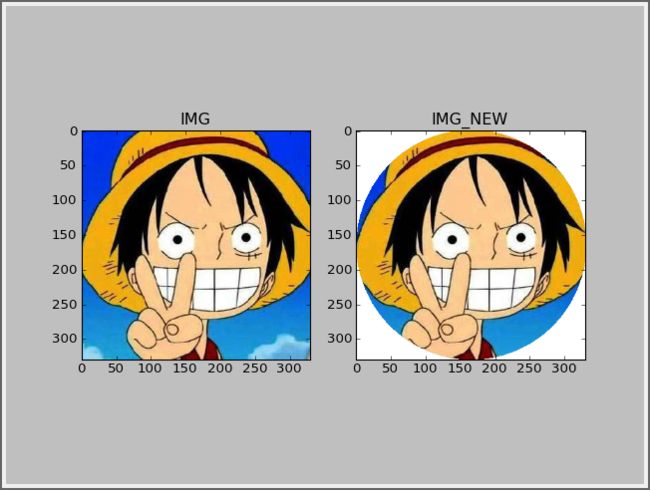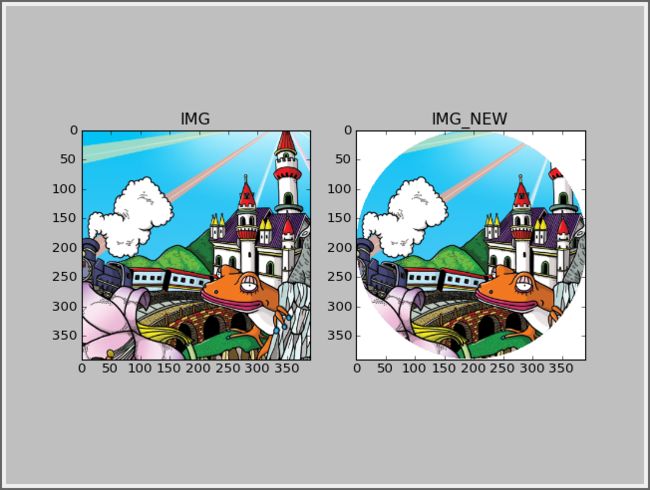OpenCV图像处理--将图像裁剪为圆形
1,需求
为了便于项目前端展示用户头像,需要将头像处理为圆形,非圆形区域设置为透明。其实,前端可以在显示的时候处理,但是前端采用WebGL,暂时搞不定,所以由后端进行图像的一次性加工。
于是,我们尝试用Linux工具Convert来完成,但是,百思无解,后续决定采用Python+OpenCV。
2,实现
优秀的代码不需要解释,直接看代码吧,O(∩_∩)O。
#coding:utf8
import numpy as np
import cv2
from matplotlib import pyplot as plt
import glob as gb
# 图像处理,获取图片最大内接圆,其他区域置为透明
def img_deal(input_img):
# cv2.IMREAD_COLOR,读取BGR通道数值,即彩色通道,该参数为函数默认值
# cv2.IMREAD_UNCHANGED,读取透明(alpha)通道数值
# cv2.IMREAD_ANYDEPTH,读取灰色图,返回矩阵是两维的
img = cv2.imread(input_img, cv2.IMREAD_UNCHANGED)
rows, cols, channel = img.shape
# 创建一张4通道的新图片,包含透明通道,初始化是透明的
img_new = np.zeros((rows,cols,4),np.uint8)
img_new[:,:,0:3] = img[:,:,0:3]
# 创建一张单通道的图片,设置最大内接圆为不透明,注意圆心的坐标设置,cols是x坐标,rows是y坐标
img_circle = np.zeros((rows,cols,1),np.uint8)
img_circle[:,:,:] = 0 # 设置为全透明
img_circle = cv2.circle(img_circle,(cols/2,rows/2),min(rows, cols)/2,(255),-1) # 设置最大内接圆为不透明
# 图片融合
img_new[:,:,3] = img_circle[:,:,0]
# 保存图片
cv2.imwrite(input_img+".png", img_new)
# cv2.imencode('.jpg', img)[1].tofile('./9.jpg') # 保存到另外的位置
# 显示图片,调用opencv展示
# cv2.imshow("img_new", img_new)
# cv2.waitKey(0)
# cv2.destroyAllWindows()
# 显示图片,调用matplotlib.pyplot展示
plt.subplot(121), plt.imshow(img_convert(img), cmap='gray'), plt.title('IMG')
plt.subplot(122), plt.imshow(img_convert(img_new), cmap='gray'), plt.title('IMG_NEW')
plt.show()
# cv2与matplotlib的图像转换,cv2是bgr格式,matplotlib是rgb格式
def img_convert(cv2_img):
# 灰度图片直接返回
if len(cv2_img.shape) == 2:
return cv2_img
# 3通道的BGR图片
elif len(cv2_img.shape) == 3 and cv2_img.shape[2] == 3:
b, g, r = cv2.split(cv2_img)
return cv2.merge((r, g, b))
# 4通道的BGR图片
elif len(cv2_img.shape) == 3 and cv2_img.shape[2] == 4:
b, g, r, a = cv2.split(cv2_img)
return cv2.merge((r, g, b, a))
# 未知图片格式
else:
return cv2_img
# 主函数
if __name__ == "__main__":
img_path = gb.glob("img/*")
for path in img_path:
print path
img_deal(path)3,效果
4,参考资料
帮助文档
- OpenCV的成套资料比较少,遇到问题还需要查看帮助文档
>>> from matplotlib import pyplot
Backend TkAgg is interactive backend. Turning interactive mode on.
>>> help(pyplot.imshow)
Help on function imshow in module matplotlib.pyplot:
imshow(X, cmap=None, norm=None, aspect=None, interpolation=None, alpha=None, vmin=None, vmax=None, origin=None, extent=None, shape=None, filternorm=1, filterrad=4.0, imlim=None, resample=None, url=None, hold=None, **kwargs)
call signature::
imshow(X, cmap=None, norm=None, aspect=None, interpolation=None,
alpha=None, vmin=None, vmax=None, origin=None, extent=None,
**kwargs)
Display the image in *X* to current axes. *X* may be a float
array, a uint8 array or a PIL image. If *X* is an array, *X*
can have the following shapes:
* MxN -- luminance (grayscale, float array only)
* MxNx3 -- RGB (float or uint8 array)
* MxNx4 -- RGBA (float or uint8 array)
The value for each component of MxNx3 and MxNx4 float arrays should be
in the range 0.0 to 1.0; MxN float arrays may be normalised.
An :class:`matplotlib.image.AxesImage` instance is returned.
...参考网页
Matplotlib调用imshow()函数绘制热图
http://blog.csdn.net/Eastmount/article/details/73392106?locationNum=5&fps=1opencv中的Circle函数
http://blog.csdn.net/yangfengman/article/details/52768862cv2.imshow官方介绍(为什么不能显示透明图片,还是不清楚)
http://docs.opencv.org/2.4/modules/highgui/doc/user_interface.html?highlight=imshow#cv2.imshowopencv不规则ROI——圆形ROI
http://www.cnblogs.com/xiangshancuizhu/archive/2011/11/16/2250931.html

